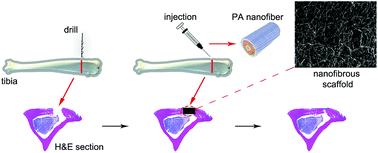A glycosaminoglycan mimetic peptide nanofiber gel as an osteoinductive scaffold†
Abstract
Biomineralization of the extracellular matrix (ECM) plays a crucial role in bone formation. Functional and structural biomimetic native bone ECM components can therefore be used to change the fate of stem cells and induce bone regeneration and mineralization. Glycosaminoglycan (GAG) mimetic peptide nanofibers can interact with several growth factors. These nanostructures are capable of enhancing the osteogenic activity and mineral deposition of osteoblastic cells, which is indicative of their potential application in bone tissue regeneration. In this study, we investigated the potential of GAG-mimetic peptide nanofibers to promote the osteogenic differentiation of rat mesenchymal stem cells (rMSCs) in vitro and enhance the bone regeneration and biomineralization process in vivo in a rabbit tibial bone defect model. Alkaline phosphatase (ALP) activity and Alizarin red staining results suggested that osteogenic differentiation is enhanced when rMSCs are cultured on GAG-mimetic peptide nanofibers. Moreover, osteogenic marker genes were shown to be upregulated in the presence of the peptide nanofiber system. Histological and micro-computed tomography (Micro-CT) observations of regenerated bone defects in rabbit tibia bone also suggested that the injection of a GAG-mimetic nanofiber gel supports cortical bone deposition by enhancing the secretion of an inorganic mineral matrix. The volume of the repaired cortical bone was higher in GAG-PA gel injected animals. The overall results indicate that GAG-mimetic peptide nanofibers can be utilized effectively as a new bioactive platform for bone regeneration.



 Please wait while we load your content...
Please wait while we load your content...